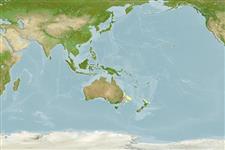Teleostei (teleosts) >
Pleuronectiformes (Flatfishes) >
Cynoglossidae (Tonguefishes) > Symphurinae
Etymology: Symphurus: Greek, syn, symphysis = grown together + Greek, oura = tail (Ref. 45335).
Environment: milieu / climate zone / depth range / distribution range
Ecology
Marine; bathydemersal. Deep-water
Indo-West Pacific: Australia.
Size / Weight / Age
Maturity: Lm ? range ? - ? cm
Short description
Identification keys | Morphology | Morphometrics
Dorsal soft rays (total): 111 - 119; Anal soft rays: 98 - 104; Vertebrae: 59 - 65. With a 1-2-2 pattern of interdigitation of proximal dorsal pterygiophores and interneural spines (ID); 9 abdominal vertebrae; 110-125 scales in a longitudinal series; whitish or yellowish blind side which is distinctly lighter than the ocular surface (Ref. 35979).
Life cycle and mating behavior
Maturity | Reproduction | Spawning | Eggs | Fecundity | Larvae
Munroe, T.A. and K. Amaoka, 1998. Symphurus hondoensis Hubbs, 1915, a valid species of Western Pacific tonguefish (Pleuronectiformes: Cynoglossidae). Ichthyol. Res. 45(4):385-391. (Ref. 35979)
IUCN Red List Status (Ref. 130435: Version 2024-1)
Threat to humans
Harmless
Human uses
Tools
Special reports
Download XML
Internet sources
Estimates based on models
Preferred temperature (Ref.
123201): 2.6 - 6.8, mean 4.4 °C (based on 42 cells).
Phylogenetic diversity index (Ref.
82804): PD
50 = 0.5000 [Uniqueness, from 0.5 = low to 2.0 = high].
Bayesian length-weight: a=0.01072 (0.00507 - 0.02267), b=3.11 (2.92 - 3.30), in cm total length, based on LWR estimates for this (Sub)family-body shape (Ref.
93245).
Trophic level (Ref.
69278): 3.3 ±0.4 se; based on size and trophs of closest relatives
Resilience (Ref.
120179): High, minimum population doubling time less than 15 months (Preliminary K or Fecundity.).
Fishing Vulnerability (Ref.
59153): Low vulnerability (10 of 100).
